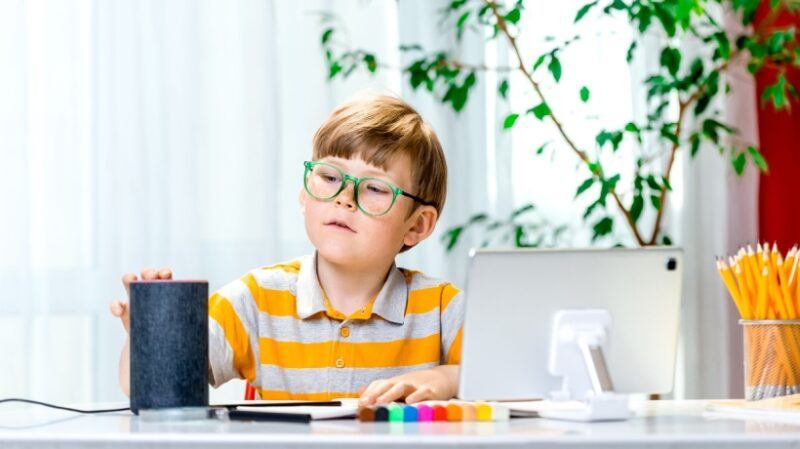How Can Teachers Use Voice Assistants At School?


Are Voice Assistants At School The New EdTech Trend?
Statistics show that in 2022, about 142 million people were using voice assistants at home, which is nearly half the population of the United States. This means that many children are familiar with entering their homes and asking these devices what the weather will be like or a question regarding a history exam. Incorporating voice assistants at school can be a tremendous help for both students and teachers, serving as their personal and trustworthy assistants. But what exactly are the benefits of using voice assistants at school, and how can teachers incorporate them into their everyday routines? In this article, you will find all the information you need to take a step towards a high-tech classroom.
4 Benefits Of Using Voice Assistants
1. Personalized Learning
Voice assistants allow students to learn at their own pace by answering questions in real time. Instead of waiting for instructions in class, they can proceed on their own without opening their books or browsing the internet to gather information. Also, this technology collects data and keeps track of each learner’s overall progress and improvement. They remind them of the projects they have enrolled in and their essay deadlines. Moreover, voice technologies assist creativity when students need a boost. For instance, if they need to write a poem, their assistant provides them with an outline or the first line, and they start to build on it.
2. Time Management
Virtual assistants manage and analyze large sets of data, and schools may utilize them to store student records as well as administrative and financial data. Teachers can delegate to their assistants the burden of tracking attendance and grading papers while they focus on student performance. Educational faculty can turn to voice technology regarding student information whenever they need it instead of searching endlessly through files. Also, learners receive any information they require about the school premises or campus facilities in just a few seconds.
3. Accessibility
Voice assistants at school benefit children with hearing and visual impairments. The first can utilize the speech-to-text function of the assistants, while the latter may ask their digital helpers to read out material from online sources. Thus, learners with disabilities enjoy independence and finish tasks a lot quicker than they would using screen readers and other assistive technologies. However, accessibility doesn’t only refer to people with disabilities. It also refers to people in remote or underprivileged areas where educational resources are scarce. Therefore, assistants bridge learning gaps by providing access to updated information.
4. Engagement And Entertainment
Imagine a voice assistant speaker installed in every classroom, with teachers and learners asking questions whenever necessary. Being able to talk to technology and get an answer makes the learning process much more engaging for children, who are often drawn to technology. Therefore, the entertainment levels in the classroom increase since everyone can engage in a debate or conversation with the assistant. Teachers may also instruct the latter to play music, read books or poems, and even narrate YouTube videos.
5 Ways Teachers Can Implement Voice Assistants
Customizable Quizzes And Tests
One invaluable benefit of voice assistants at school is that they allow teachers to customize tests and quizzes to correspond with their teaching points. They don’t need to possess coding skills since most assistants offer ready-made templates that can be easily modified. For example, educators can choose a quiz template to design a short assessment for students to check their knowledge on a topic. Additionally, assistants offer real-time feedback during reading assessments in class. They identify all the mistakes and repetitions and inform the teacher of all the corrections, helping them group their feedback points and intervene at the end of a reading session instead of continuously interrupting.
Reading Practice And Stories
When each kid has to practice reading for 15 minutes in a classroom of 25, it adds to 6 hours of a teacher’s day. Incorporating voice assistants helps teachers take a step back and let technology listen to their mistakes, correct them, and encourage students to proceed. Educators intervene only when necessary or when a learner has questions that assistants can’t explain comprehensibly. This practice is useful in primary school, where kids learn how to read, and in foreign language learning. Additionally, teachers can utilize this tool to read stories to children as entertainment, thus protecting their throats from strain.
Podcasts
Voice assistants are a valuable tool not only at school but also for remote college students. Instructors record their lectures and upload them as podcasts. Everyone is granted access by asking their assistant to download and play them. Students also listen back to lectures they’ve already participated in during revision at home. Therefore, they prepare for essays, assessments, and exams at their own pace, pausing the material whenever they want. Listening to the narration without having to stare at a screen helps them stay focused and engaged without getting distracted by various open tabs.
Ask Questions And Get Answers ASAP
Learners often spend endless hours researching a topic, trying to find trustworthy information, and clearing doubts. Teachers may be out of reach for hours to answer questions and clear up misunderstandings. Utilizing voice assistants at school and college speeds up the process of offering coveted answers. Such quick assistance is invaluable for administrative tasks as well. Faculty can use voice technology to automate phone, text, and online chat systems. As a result, students and their parents can access information automatically, even when staff are offline.
Use Them As Personal Assistants
Educators are often bombarded with a multitude of tasks and responsibilities in class, leaving them very little time to polish their skills and help students with difficulties. Therefore, they can delegate certain tasks to voice assistants. For example, they can utilize their devices to set timers for each activity, give instructions to pupils, and answer common questions. Consequently, they can devote more time to being creative and offering personalized help to learners. Additionally, assistants can replace PA systems by making announcements through smart speakers without the teacher’s participation.
Things To Consider
However convenient voice assistants may be at school and home, they come with potential risks and challenges. Voice technology was not initially made for educational purposes and, therefore, collects data and personal information. This is a serious concern that institutions must address before installing voice assistants and set strict safety measures to avoid confidential details falling into unauthorized hands. Additionally, some assistants were made for consumer use and may not function properly on school district networks. Before choosing a brand, institutions must thoroughly research the market for an appropriate assistant. Last but not least, schools should limit, if not stop, targeted advertisements, a practice most voice technologies follow to promote extra services that cater to children’s preferences.
Conclusion
Like with every technological tool, voice assistants at school offer tremendous benefits if used properly and ethically. Teachers should train students on how to use them and not rely heavily on them to find simple answers. For example, if they have trouble spelling a word, they can first try on their own and then ask the voice technology. However, learners should not blindly trust a voice assistant’s answers and double-check everything. Also, they must use polite language to talk to their devices. Sometimes people forget their manners when speaking to technology, something teachers are responsible for correcting.
Source link



